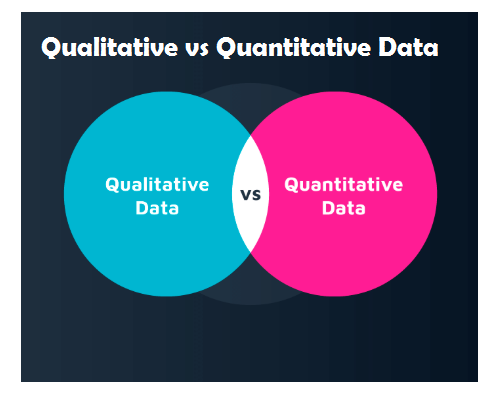Difference Between Qualitative And Quantitative Data
What is qualitative data?
Qualitative data is defined as approximate and categorical data. Qualitative data can be observed and recorded. This data type is numeric. This type of data is collected through methods of observation, one-to-one interviews, focus groups and similar methods. Here you will come to know that how are qualitative and quantitative different with examples.

Types of qualitative data
Qualitative data collection is exploratory in nature and involves in-depth analysis and research.
Here are qualitative data collection methods:
1. One-to-One Interviews: One of the most commonly used data collection tools for qualitative research, mainly because of its personal approach.
2. Focus groups: This happens in the context of group discussion. The group is limited to 6-10 people and a moderator is appointed to moderate the ongoing discussion.
3. Record Keeping: This method utilizes existing trusted documents and data sources as a data source. This data can be used in new research.
4. The process of observation: In this qualitative data collection method, the researcher immerses him / her in the background of the respondents and is attentive to the participants and pulls out the notes.
5. Longitudinal studies: This method of data collection is repeated over a long period of time on the same data source.
6. Case Studies: In this method, data is collected through an in-depth analysis of case studies.
Two Main Approaches to Qualitative Data Analysis
- Deductive Approach
The deductive approach involves analyzing qualitative data based on a structure that is predetermined by the researcher. - Inductive Approach
The inductive approach, on the contrary, is not based on a predetermined structure or set ground rules or framework.
5 Steps to Qualitative Data Analysis
These simple steps will make sure a robust data analysis.
Step 1: Arrange your Data
Step 2: Organize all your Data
Step 3: Set a Code gor the collection of data
Step 4: Validate your Data
Step 5: Concluding the Analysis Process
What is quantitative data?
Quantitative data is defined as the value of data in the form of counts or numbers, where each data-set has a unique numerical value associated with it. Any data that can be used for mathematical calculations and statistical analysis can be used to make real life decisions based on these mathematical derivatives.
Quantitative Data: Analysis Methods
Data collection forms a main part of the research process. There are different methods of analyzing quantitative.
They are:
- Cross-tabulation
- Trend analysisMaxDiff analysis
- Conjoint analysis
- TURF analysis
- Gap analysis
- SWOT analysis
- Text analysis
Qualitative VS Quantitative Data
Qualitative data
1. Advantages of Qualitative Data
• It helps in-depth analysis
• Understand what customers think
• Rich data
2. Disadvantages of Qualitative Data
• Time-consuming
• Not easy to generalize
• Is dependent on researcher’s skills
Quantitative Data
1. Advantages of Quantitative Data
- Conduct in-depth research
- Minimum bias
- Accurate results
2. Disadvantages of Quantitative Data
- Restricted information
- Depends on question types
Quantitative Data vs Qualitative Data
Quantitative Data Qualitative Data
Associated with numbers Associated with details
Implemented when data is numerical values. Implemented when data can be segregated in proper arrangements.
Collected data can be significantly analyzed Collected data can just be observed and not evaluated properly
Examples: Temperature, Height, Weight, Time, Price, etc. Examples: Flavors, Scents, Appearance, Beauty, Colors, etc.
